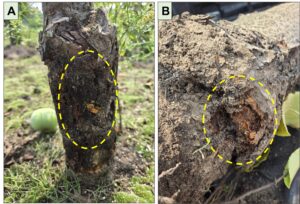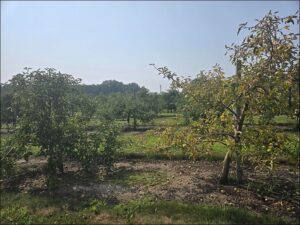I am hearing from apple growers and my entomology colleagues in neighboring states that the dogwood borer is becoming a more common insect pest to monitor and manage in apple orchards. So, in this issue of Facts for Fancy Fruit, I’ll share some general tips to help you stay ahead of this damaging fruit tree pest.
What is the dogwood borer? A clear-wing moth that at first glance, may be mistaken for a wasp, given its black and yellow coloration (Figure 1).
What orchard trees does it attack? Apples and plums, but it can also feed on many different forest trees.
Which life stage causes the damage? As with most moth pests, it is the caterpillar that causes injury to trees.

Figure 2. Examples of dogwood borer caterpillar injury to apple trees. Repeated years of infestation leads to obvious, severe injury and girdling of trees (A), while early infestations may not be as obvious, but note presence of reddish, sawdust-like frass (B). Photos: E. Y. Long
Why is it so damaging? This insect spends most of its life (more than one year!) as a caterpillar, feeding preferentially in burr knots (adventitious roots) around the graft union of the tree (Figure 2), then moving below the bark. Injury can be easy to miss because caterpillars are out of sight! This is where the dogwood borer can be a really insidious pest: if trees are not inspected closely, it can be easy to miss signs of the caterpillars year after year, until they have girdled the tree. Moreover, there is evidence that previously-infested trees are more attractive to female moths for egg laying, so failing to detect infestations early can lead to increasing pressure (caterpillar load) on already injured apple trees. Generally, decline due to dogwood borer is slow, requiring several years of infestation to kill apple trees (Figure 3).

Figure 3. A healthy apple tree (left) versus an apple tree in decline (right) due to repeated years of infestation by dogwood borer caterpillars. Photo: E. Y. Long
Helpful tips to help you stay ahead of this insect. Keep the area around the lower trunk and graft union weed-free and open to sunlight as much as possible. This makes the tree less hospitable to female moths and reduces development of burr knots, respectively, on rootstocks prone to burr knot development.
In the spring, look for signs of caterpillars beneath tree guards. Pay special attention to burr knots and look for reddish, sawdust-like caterpillar frass (solid waste) on the bark (Figure 2). Remove tree guards when they are no longer needed, as these can provide protective shelter for egg-laying females and the developing caterpillars.
If there is a history of dogwood borer injury in your orchard, or if you are unsure, use pheromone traps to get a baseline measure of moth activity in your orchard. Place pheromone traps beginning in June through August, when adult moths are flying and laying eggs. Be sure to place traps 4 to 6 feet from the ground, as this is the ideal placement to get the best capture of dogwood borer moths. Mating disruption is also an effective strategy against this insect; however, this approach is most effective with multiple years of use.
White latex paint can be used on tree trunks to deter female moths from laying eggs on trees and mosquito netting can be installed as a physical barrier to prevent egg laying on trees. When needed, pyrethroid and neonicotinoid insecticides can be applied as trunk sprays targeting any burr knots and the lower four-feet of trunk, soaking the bark. A single spray in late-June is the best timing against this pest in the Midwest, which coincides with peak egg hatch.
Last but not least, there are several other caterpillars and beetles that bore into orchard trees, so if you see signs and symptoms of this activity, be sure to take photos and send them to the Purdue Plant and Pest Diagnostic Lab so we can confirm the culprit (insect or otherwise!) and provide the best recommendation for protecting your trees.
